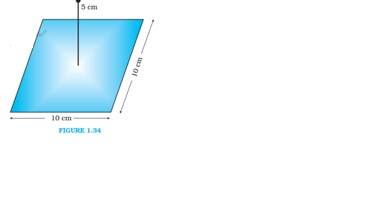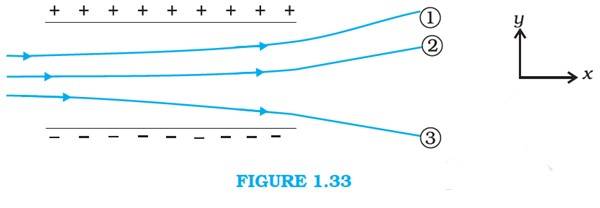Ncert Solutions Physics Class 12th
Get insights from 218 questions on Ncert Solutions Physics Class 12th, answered by students, alumni, and experts. You may also ask and answer any question you like about Ncert Solutions Physics Class 12th
Follow Ask QuestionQuestions
Discussions
Active Users
Followers
New answer posted
5 months agoContributor-Level 10
1.18 The square can be considered as one face of a cube of edge 10 cm with a centre where charge q is placed.
According to Gauss's theorem for a cube, total electric flux is through all its six faces.
i.e. through the square is = ,Where= Permittivity of free space = 8.854
We have q = +10
Hence, = = == 188238.83 N = 1.88 N
New answer posted
5 months agoContributor-Level 10
1.17 (a) Net outward flux through the surface of the box , = 8.0 * C
For a body containing net charge q, flux is given by the relation,
=
where= Permittivity of free space = 8.854
Hence q = = 8.0 * 8.854 C = 7.0832 C
= 7.0832
(b) Net flux piercing out through a body depends on the net charge contained in the body. If net flux is zero, then it can be inferred that the net charge inside the body is zero. The body may have equal amount of positive and negative charges.
New answer posted
5 months agoContributor-Level 10
1.16 When the cube side is oriented so that its faces are parallel to the coordinate planes, number of field lines entering the cube is equal to the number of field lines piercing out of the cube. A as a result, net flux through the cube is zero.
New answer posted
5 months agoContributor-Level 10
1.15 (a) Electric field intensity, E = 3 î N/C
Magnitude of electric field intensity, =
N/C
Side of the square, s = 10 cm = 0.1 m
Area of the square, A = = 0.01
The plane of the square is parallel to the y-z plane, hence the angle between the unit vector normal to the plane and electric field, = 0
Flux ( through the plane is given by the relation, = =
C
(b) When the normal to its plane make a 60 angle with x-axis, = 60
. From the equation =we get =
C
New answer posted
5 months agoContributor-Level 10
1.14 Since the charges 1 & 2 are attracted towards + ve, their charges will be – ve. The charge 3 is attracted towards – ve, hence its charge will be +ve.
The charge to mass ratio (emf) is directly proportional to the displacement, charge 3 will have the highest charge to mass ratio.
New answer posted
5 months agoContributor-Level 10
1.13 When the third uncharged sphere C is brought in contact with the sphere A, then the charge is shared and becomes half. Then
= and = =
When the charged sphere C is brought in contact with charged sphere B, the charge between both the sphere is shared and becomes half
(q + =
Hence the force of repulsion between sphere A and B can be given as
F =
, where = Permittivity of free space = 8.854 = = = =
=
= 5.695N
New answer posted
5 months agoContributor-Level 10
1.12 (a) Charge on sphere A, = 6.5 C
Charge on sphere B, = 6.5 C
Distance between the spheres, r = 50 cm = 0.5 m
Force of repulsion between two spheres
F =
, where = Permittivity of free space = 8.854
Therefore, F =
N = 0.0152 N = 1.52 N
(b) Charge on sphere A, = 2 6.5 C = 1.3
Charge on sphere B,
Distance between the spheres, r =
Force of repulsion between two spheres
F =
New answer posted
5 months agoContributor-Level 10
Ans.1.12
(a) Charge on sphere A,
Charge on sphere B,
Distance between the spheres, r = 50 cm = 0.5 m
Force of repulsion between two spheres
F =
(b) Charge on sphere A,
Charge on sphere B,
Distance between the spheres, r =
Force of repulsion between two spheres
F =
New question posted
5 months agoNew answer posted
5 months agoContributor-Level 10
1.11
(a) When polythene rubbed against wool, a number of electrons get transferred from wool to polythene. Hence, wool becomes positively charged and polythene negatively charged.
Amount of charge on the polythene piece, q = -3
Amount of charge of 1 electron e = -1.6
So number of electron transferred from wool to polythene
=
-
(b) Since electron has a mass, so there will be transfer of mass also.
Mass of single electron,
Total mass transferred from wool to polythene = 1.875
= 1.706
Hence a negligible amount of mass is transferred from wool to polythene.
Taking an Exam? Selecting a College?
Get authentic answers from experts, students and alumni that you won't find anywhere else
Sign Up on ShikshaOn Shiksha, get access to
- 65k Colleges
- 1.2k Exams
- 687k Reviews
- 1800k Answers


